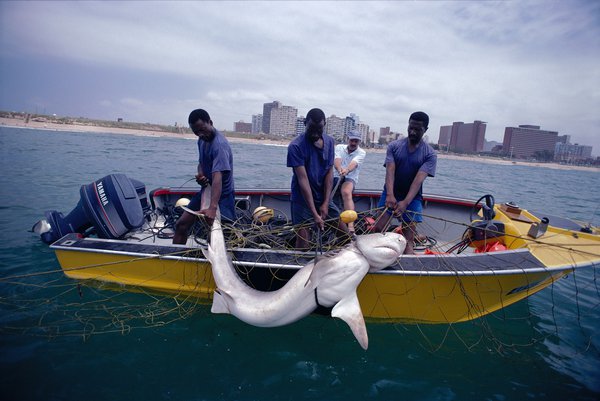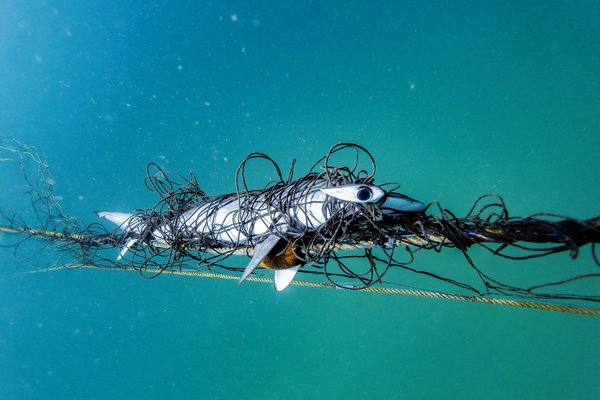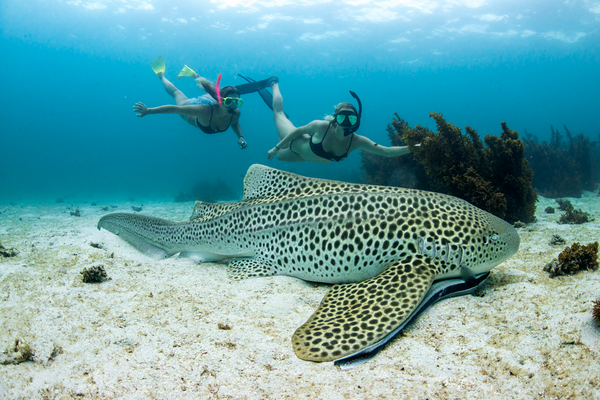Saving sharks
We can all take action to help save the world’s shark populations. Knowledge from the First Nations peoples, scientists and ecologists can guide our next steps.


Protecting our oceans
Action is needed and fast. The biggest issues are overfishing, finning and bycatch. Add global warming, pollution and shark nets, and sharks are facing quite a line-up of threats.
We can use the knowledge and attitudes of First Nations peoples, scientists and ecologists to guide our next steps.
Video Transcript
When people think of sharks and they say the word shark an image will come into their head and hopefully what I'm doing can somewhat replace that image and give people a new perspective. Being an artist who creates a specific scientific illustration, you have to make sure that you're capturing these details. And especially with a lot of the sharks, the differences are so subtle. I think it really makes people pause more and hopefully in doing that, appreciate the complexity of the animal.
I loved painting the Prickly Dogfish. They look like a little football and you have to represent that little football shape from the side, which was quite hard to do because I really wanted to make sure I showed that, and it's got little spines on the fins, and then the whole body is also covered in these really spiky denticles, which is the scales. It's so important to be able to see and identify animals correctly because that's the key to their conservation.
Marine Reserves are going to become more and more important for protecting our oceans and our ecosystems. Sharks that live on coral reefs benefit hugely from marine protected areas or shark sanctuaries, because these are species that don't move too far and so putting a protected area in will actually have really profound benefits for those populations.
There's 25 times as many sharks inside the meso reserve as just outside of it. Additionally, even biodiversity has gone up.
For species that live in the open ocean or migrate over thousands of kilometers spatial protections are more complicated. They can still be very useful, but the benefits they deliver are probably less.
Unfortunately, sharks don't see the borders that we do between countries, so they occupy the habitat that they have for thousands of years. There's no point one country solving the problem for sharks if those sharks just swim off to another country and get caught there, and so international cooperation is going to be actually one of the really important keys. And we're seeing that start to happen, but it's relatively slow and we need to speed that process up.
We talk about totems as in it's something that you come from birth, you get connected to. You have multiple totems, not just one, but the way that we could sort of explain these is as a symbol of something that is living, something that holds life, something that holds purpose, and you have connection to it. And when we talk about connection, it's always a spiritual connection - our ancestors were very spiritual people. The way that we are being taught today, we are still very spiritual people. We believe in good and bad spirits. We believe in all of that. And so when we talk about connection and totem, it's a spiritual connection and gives you obligation to take care of something.
Because there were so many shark attacks happening along the East Coast that the government decided to put in shark nets. And one of the issues that was coming out of the shark nets was that a lot of non-target species were being captured, and these non-target species are essentially cultural species and they'd have value and significance, the same as in totemism or kinship to lots of mobs along the coast. For example, up around Byron, the Arakwal , their totem is the dolphin. So there were dolphins being caught in this net. Whales, Humpback Whales, which is the south coast people's totemic species. There were sharks, which are like my cousins. So instantly you think what was the struggle and what was the feeling of our kin and our brothers and sisters in this ocean medium as they were caught in these nets and struggling for their life. And in some instances you had mothers and their young. And you think about that and of course, it almost brings a tear to my eye and it does and I have had to have cries about this because it's unethical and it doesn't show respect at all.
Well, in terms of shark conservation, while we can not buy anything that has shark product in it, the shark collagen, shark liver oil, even shark meat that we could find at a fish and chip shop, perhaps that's one thing that we can do.
There's a lot of people in the world who rely solely on fishing for their food and for their existence and things like that so I think funding needs to go towards making it sustainable.
So there's a whole range of things that we have to do to actually make sure that sharks get through this real crisis that they're facing. We need to enhance the value of all of the things that we're doing to help save sharks, be it sanctuaries, marine protected areas, fishing regulations, bycatch handling regulations and guidelines, poverty alleviation. All those things are all going to have to happen.

If we're going to return the oceans to health, we have to return those predators to health, because they play a critical role in the ecosystem.
Taking action
Protect species
In Australia, most sharks can be legally caught by commercial and recreational fishers. Several species are protected. These include:

Ban shark finning
Live shark finning is fully or partially banned in many countries and jurisdictions. Some Pacific countries have taken things a step further. Should every country follow their example?

Live shark finning is fully or partially banned in many countries and jurisdictions, including:
- Australia
- Aotearoa New Zealand
- French Polynesia
- The Cook Islands
- Tokelau Islands – no shark fishing in territorial waters
- Fiji
- Kiribati - no commercial fishing in the Phoenix Islands Protected Area and Southern Line Islands.
Some Pacific countries have taken things a step further:
- American Samoa has banned the sale, possession, and distribution of fins and other shark parts.
- New Caledonia has banned the sale of shark products and banned shark fishing in its Exclusive Economic Zone.
- The Cook Islands and Kiribati have banned commercial shark fishing and the possession, sale and trade of shark products.
- Palau has banned commercial shark fishing within its Exclusive Economic Zone.
What can I do to protect sharks?
We can all take action to help save the world’s shark populations. Here are some suggestions.
Buy smart
- Read labels
Avoid beauty products and supplements that contain squalene or shark liver oil. - Buy sustainable seafood
Buy seafood that has been sustainably sourced. See goodfish.org.au. - Shop smaller
Buy from smaller, local fishmongers. - Ask
When you buy fish and chips, ask what the fish is. If it's shark or flake (another name for shark meat) don't buy it. Explain why. - Avoid
Don't go to restaurants that sell shark fin soup.

Be sea smart
- Be safe
Learn about shark water safety. By keeping yourself safe, you'll also protect the sharks. - Deter sharks
Support your local beaches using non-lethal shark deterrents like tagged shark listening stations, drone surveillance and SMART drumlines. - Local knowledge
Find out more about First Nations peoples' local knowledge of the sea and relationships with sharks.

Get political
- Protect
Support the creation of marine protected areas or shark sanctuaries. - Better fishing
Support campaigns that promote better fishing practices. - Ban finning
Write to your local representative asking them to support a ban on shark fin trade in Australia. - Action for climate change
Vote for a political party that will work towards meeting the Paris Agreement's 1.5°C pledge (Australia is currently not meeting this). - Sign a petition
Sign a petition to save sharks: sharkchampions.org.au. - Support FNA laws
If you live in Western Australia, the Northern Territory or Queensland write to your local representative asking them to support a 'Fins Naturally Attached' (FNA) law.

Get social
- Share
Share what you have learnt with others and encourage them to take action. - Citizen science
Join a citizen science project: sharktrust.org. - Cleanup
Take part in local plastic cleanups like 'Clean Up Australia Day'. - Plant trees
Volunteer to plant trees to counter global warming.

Land and sea rights
In 1993 the Native Title Act was passed. It allows Australian First Nations peoples access to land for living, traditional purposes, hunting or fishing and/or to teach laws and customs.
It’s a difficult concept for an Aboriginal person to say that the land and the sea aren’t connected. They are connected, and as far out as you can see to the horizon, which is a very different concept of property rights.

Protecting people and sharks
White, Bull and Tiger Sharks all have bad reputations for biting people and shark meshing beaches make swimmers feel safe.
While the public see nets as being the best way of keeping people and sharks apart, they’re not fail-safe. The nets don’t form a complete barrier and sharks caught in them usually die.
Because nets don’t discriminate between species, they also kill sharks that are protected and other species of marine animals, including whales, dolphins, turtles, fishes and rays.
New shark conservation programme
The underwater equivalent of rewilding is set to happen in West Papua.
Shark finning has devastated Zebra Shark populations worldwide. Australia, however, still has relatively healthy numbers of this shark.
Zebra Sharks, Stegostoma tigrinum, do very well in captivity and breed like rabbits, according to scientist and ecologist, Mark Erdmann. He and his team are breeding Leopard Sharks in aquaria in Australia and the USA and will ship the eggs to Raja Ampat, where they’ll be released into the wild after they’ve hatched.
This will be the first reintroduction programme for an endangered shark species.
We're hopeful that this will lead the way for doing that in other places around the world, because we're going to need that if we're going to recover our shark populations.
Marine reserves
Marine reserves sound like a great way of protecting sharks and other marine flora and fauna. But there are reserves and ‘reserves’. Some are strict ‘no-take’ areas, while ‘partially protected areas’ allow commercial fishing and mining.
Globally, 2.7 per cent of the world’s oceans are fully protected in no-take marine national parks or their equivalents.
With 58 marine parks covering 37 per cent of its oceans, Australia has one of the largest marine protected area networks in the world. But with three-quarters of parks open to fishing, only about 15 per cent of Australia’s oceans are fully protected no-take areas.








